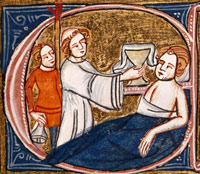 |
 |
 |
 |
 |
 |
 |
|
Life in the infirmary (5/13) For those who stayed in the infirmary, life was relatively comfortable. It was tranquil, airy and warm. The inmates enjoyed a more relaxed diet, including meat, which was otherwise forbidden - at least, it was prohibited until the fourteenth century, when dietary concessions were made. The sick were also served a light breakfast called the mixt. The inmates of the infirmary were not expected to follow the full rigours of monastic life and concessions were made regarding reading, working and spiritual observances. Still, it was important that each monk did as much as he was able and that he observed silence. Necessary conversation was, however, permitted with the infirmarer. Only the critically ill were exempted from attending Mass and the Canonical Hours. Everyone else was expected to participate in these services in the abbey church and would have taken his place in the retrochoir, the area directly behind the monks’ choir. The night office of Vigils was celebrated in the infirmary chapel, which was easier to access in the early hours of the morning. Vigils here was also shorter than in the church. Whenever the inmates from the infirmary went to the abbey church they were not to loiter in the cloister or attempt to communicate with the other monks; they were outside the cloister and had to observe this separation. Any monk who had a cut or a swelling
and required physical treatment
in the infirmary, yet was otherwise unaffected and had a healthy
appetite, was not granted any dietary concessions while residing
in the infirmary,
nor was he permitted to lie on a quilt.(5)
|
